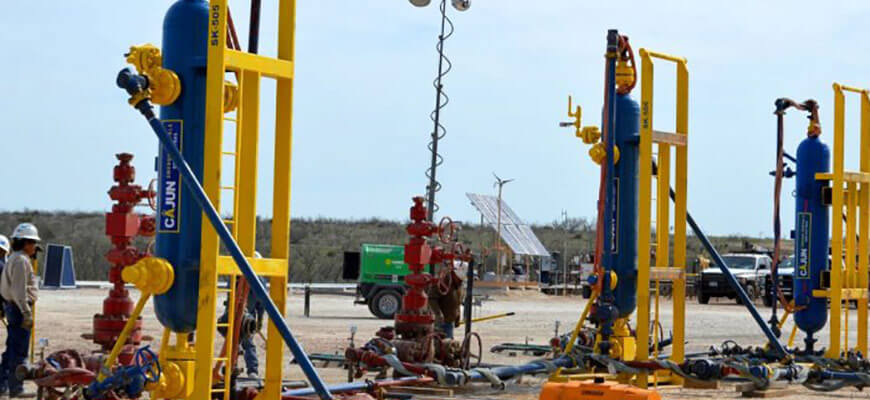
How to Control Sand Production in Oil and Gas
Sand is one of the many impurities that contaminate oil recovered from natural reservoirs. Sand is typically produced thanks to the degradation effects of oil recovery like pumping pressures, level of particle consolidation and the level of viscosity of fluids flowing through the production well.
The sand accumulated within these reservoirs is pumped to the surface alongside recovered hydrocarbons, process fluids, and produced water. Controlling the amounts of sand generated by oil and gas processes is vital to their sustained efficiency and productivity.
What Is the Sand Problem in Oil and Gas Production?
The generation of sand during oil and gas recovery processes can damage and cause critical failure in production equipment. Identifying the causes and effects of sand associated with oil and gas production is key to effective sand control and process optimization.
Causes and Effects of Sand Production in Oil and Gas
The different causes and effects of sand generated by oil and gas exploration are dependent on factors including product recovery techniques and the type of geological formation explored.
Outlined below are the most common reasons sand is produced in oil and gas, as well as the effects it exerts on the overall industrial process.
Causes
Sand production in the oil and gas industry is dependent on factors like the degree of cementation, erosion from production, decreased pore pressure, viscous formation fluids, and increased pressure.
Extent of Cementation/Consolidation
Although cementation and consolidation are sometimes used interchangeably, they are two distinct terms. The cementation of sand within an oil and gas reservoir refers to the strength of the adhesion of its particles. This aggregation property determines the ability of the formation to sustain drilled tunnels. The older the collected sand is the more resilient its cementation is.
By comparison, consolidation refers to how tightly sand grains are packed within the soil matrix. Just like with cementation, the consolidation of sand within an oil reservoir improves with age. As a result, a higher output of sand is associated with hydrocarbons recovered from a younger reservoir with less consolidation and a lower degree of cementation than a well-aged well.
Production Related Erosion
High output oil recovery subjects the formation surfaces to wear down, which dislodges sand particles and increases sand production. The high formation pressures, particularly during early phases of oil production, are associated with a faster rate of erosion and sand accumulation. This elevated rate of sedimentation can be attributed to increased drag forces acting on rocks demarcating the extent of the reservoir.
Decrease in Pore Pressure
Sand grains consolidated within oil-bearing formations typically lend support to overlying rocks as a result of transmitted pressure from their oil and gas contents. With sustained removal of these fluids, formation pressure drops, and this translates to the weakening of overlying sand/rock structures. Rocks will start to breakdown rapidly resulting in an increased production of sand.
The Viscosity of Formation Fluids
The consistency of fluids contained within an oil-bearing reservoir is another critical factor that contributes to the rate of sand generation. The higher the viscosity of the fluids contained within a reservoir, the more rapid the rate of erosion and sand generation that occurs at its rock faces.
Increased Water Production/Injection
The introduction of an increased amount of water into an oil well will increase the sand production rate by the following mechanisms
- A decrease in rock capillary pressure causing loss of consolidation integrity
- Increased friction generating more surface wear
- Loss of cementing material due to dissolution in water
Effects
The effects of sand generation are always negative in short-term production activities. These unwanted consequences are usually machinery related and cost operators by reducing productivity and raising expenses.
Accumulation Downhole
Reduction in rate of production that occurs with a reduction in formation pressures results in an inability to transport sand to the surface. The sand generated will continue to accumulate within drilled transport channels until complete obstruction and cessation of production occur.
Accumulation within Process Equipment at the Surface
In cases where the pressure within oil reservoirs is enough to channel the associated sand to the surface, there is still a risk of accumulation in oilfield flowback equipment. Unchecked, sand particles can accumulate in sand and test separators, production flow lines, and heat systems.
Equipment Erosion
Turbulent fluid flow within production channels will rapidly erode and damage equipment both at the surface and within reservoir channels. Prolonged unchecked wear will lead to equipment failure and halt the production process.

Sand Consolidation Methods & Common Sand Control Technology
While oil and gas operations are now using monitoring and detection techniques targeted at predicting sand removal, traditional methods of sand consolidation are more pre-emptive.
Routinely conducted sand prevention techniques include
- Chemical consolidation
- Oilfield separators
- Cyclonic and gravity-fed sand traps
- The use of special screens, filters, and slotted liners
- Gravel packing within casings
- Open-hole packing
- Propped fracking
- Selective and oriented perforating
- Production rate maintenance
Oilfield sand separators are particularly effective in eliminating sand in newly explored wells as they help preserve downstream equipment while boosting production efficiency.
Protect Your Production with Cajun Energy Sand Control Equipment
Cajun Energy is a trusted flowback and well testing equipment and service provider that has been serving customers since 2011. We offer top-notch services designed to optimize productivity in the oil and gas industry.
Contact us online today to learn more about our equipment rentals and flowback services.